Michigan State Assistant Professor Jinxing Li can sum up an ingenious project his team is working on, which can bring buildings to life, fairly succinctly.
"It's a simple idea: basically, let's engineer microbes to build better materials for us," Li said in MSU Today. "That's like 10 words but, with all the science and reasoning that goes into it, our research plan was closer to 15 pages."
The breakthrough lives up to the hype, no matter how long it takes to describe it. That's because the material Li's team is developing can self-heal while cleaning pollution from the air, according to the experts.
The fascinating feats are accomplished by using a biomass "ink" that 3D printers use to create building materials. The ink is made from agricultural waste, what the MSU team calls "the parts of plants that farmers can't sell."
"Around MSU and in the Great Lakes region, we have rich biomass resources," Li said in the MSU report. "We believe this can be scalable locally and nationally."
This biomass brings lignin and cellulose, which give the MSU building materials strength. Finally, the researchers add miniscule fungi and bacteria — part of what makes the innovation truly alive.
With the help of science, the tiny microbes help to form "polymers and minerals," adding more strength, as well as other benefits, per MSU.
"As the materials start to show signs of aging and stress — such as microcracks — the microbes can also work to heal these damage sites. What's more, the microbes collect carbon from the atmosphere to do this," per the research team's report.
The project was boosted with a $2 million grant from the National Science Foundation. The funding opportunity also includes colleagues at Purdue University.
"To reduce greenhouse gas emissions and fight climate change, there is strong demand in sustainable materials," Li said in the MSU story.
The university experts are not alone in looking to biology for better building practices. Researchers at the United Kingdom's Newcastle University are also using fungi to make a building material they call mycocrete.
At Sweden's Lund University, scientists are studying termite mounds, learning how the creature's use of geometry can improve airflow in our buildings. It's part of the way we can better utilize the energy in our homes to reduce air pollution and even save money.
A closeup photo of MSU's microbe-made material doesn't look like something from which you'd build a home. It sort of resembles an abstract photo of a wheatfield, but the caption assures the viewer that the microbes are "at work" on the biomaterial.
It's part of a path that researchers hope leads to low-cost homes built with sustainable materials that "repair themselves" and clear air pollution, according to MSU.
"This is definitely a high-risk, high-reward project. There was a lot of uncertainty initially due to the complexity of the project and its cross-disciplinary nature," Li said in the MSU story. "But when you find the right team, there's a resonance. You start building ambition and rationale together — and creating opportunities."
Join our free newsletter for weekly updates on the coolest innovations improving our lives and saving our planet.









